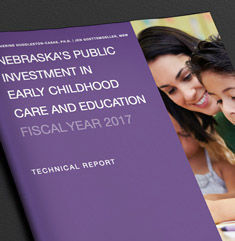
Buffet Early Childhood Institute Reports and Publications
Date of this Version
2019
Document Type
Article
Citation
Welch, G.W., Svoboda, E.A., Garrett, A., Gallagher, K., Goldberg, M., & Daro, A. (2019). 2019 Nebraska Child Care Market Rate Study. University of Nebraska: Buffett Early Childhood Institute. https://buffettinstitute.nebraska.edu/resources/reports-publications
Abstract
The Child Care and Development Block Grant (CCDBG) Act of 2014 was reauthorized with renewed emphasis placed on the Child Care and Development Fund (CCDF) program, which seeks to provide equal access to quality child care for families. The CCDF program is necessary to ensure children from low-income families have the opportunity to experience stable, high-quality early experiences while their parents experience a pathway to economic stability. A primary goal of the CCDF program is to ensure that low-income families receive CCDF funds to help them access quality child care in the same manner as families that pay the full rate for child care services (Davis et al., 2017). The CCDBG Act requires Lead Agencies to engage in a number of activities designed to inform families receiving CCDF assistance, the general public, and child care providers of various aspects of the new law. This includes a requirement for Lead Agencies to conduct a market rate survey or alternative methodology to establish provider payment rates. Various factors should be considered when provider payment rates are established to ensure children from low-income families have equal access to highquality child care. Federal regulations indicate that the 75th percentile payment rate is a benchmark for gauging equal access for families receiving subsidy. However, States/ Territories are given the freedom to determine their own rates and eligibility requirements for families and programs. The Nebraska Department of Health and Human Services (NDHHS) is the CCDF Lead Agency in Nebraska. While the reauthorized CCDBG allows states to conduct a market rate survey every three years, state legislation requires that NDHHS adjust the reimbursement rate for child care every odd numbered year. For 2019, NDHHS contracted with the Buffett Early Childhood Institute (referred to as Institute throughout the remainder of this manuscript) at the University of Nebraska to conduct a market rate survey (MRS) for child care in the state of Nebraska. The 2019 MRS was designed to meet the following federal benchmarks: (a) includes the priced child care market; (b) provides complete and current data; (c) represents geographic variations; (d) uses rigorous data collection procedures; and (e) analyzes data in a manner that captures market differences as a function of age group, provider type, and geographic location (45 CFR § 98.4).
Included in
Child Psychology Commons, Developmental Psychology Commons, Early Childhood Education Commons, Educational Psychology Commons, Educational Sociology Commons, Education Economics Commons, Education Policy Commons, Policy History, Theory, and Methods Commons, Pre-Elementary, Early Childhood, Kindergarten Teacher Education Commons, School Psychology Commons


Comments
Copyright © 2019 Buffett Early Childhood Institute.